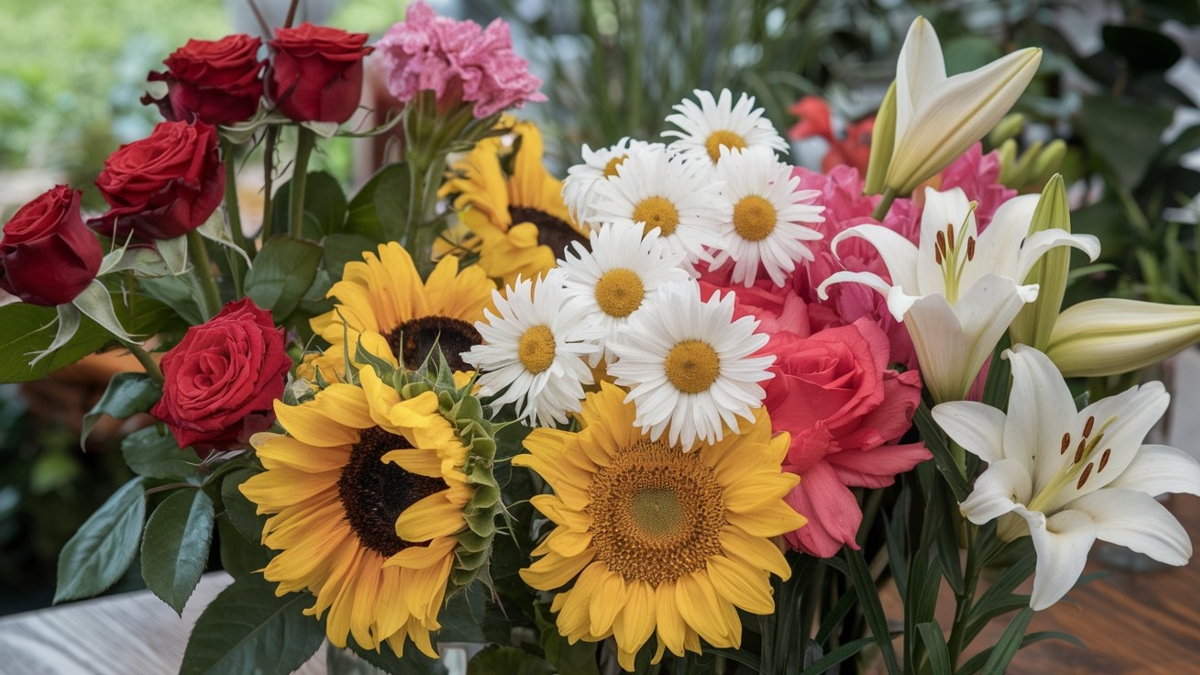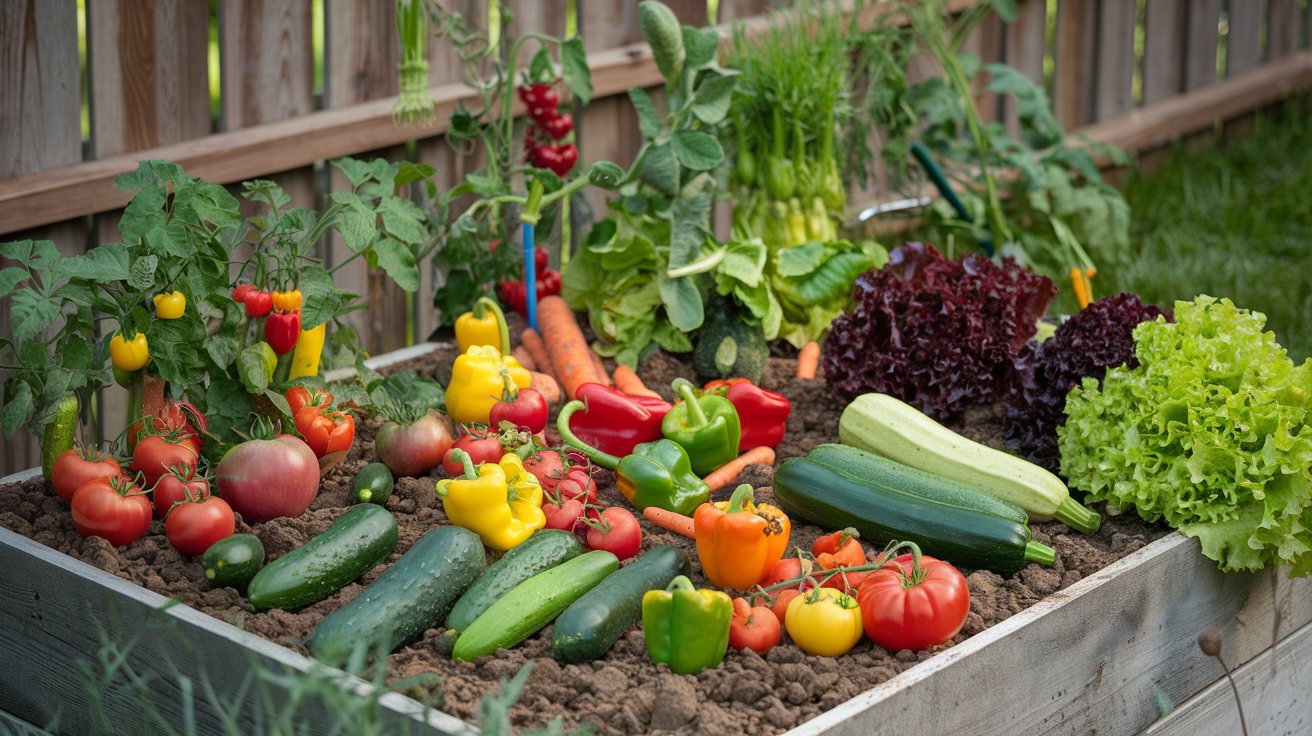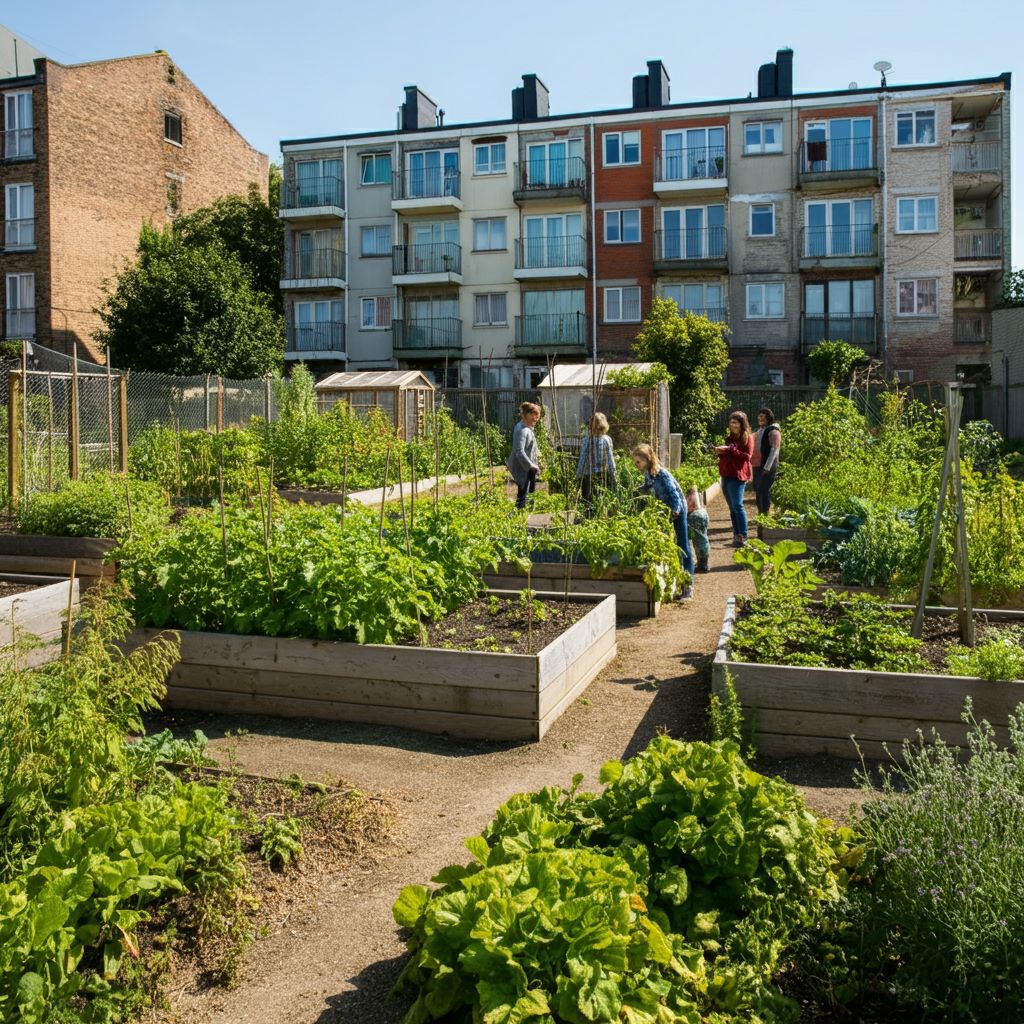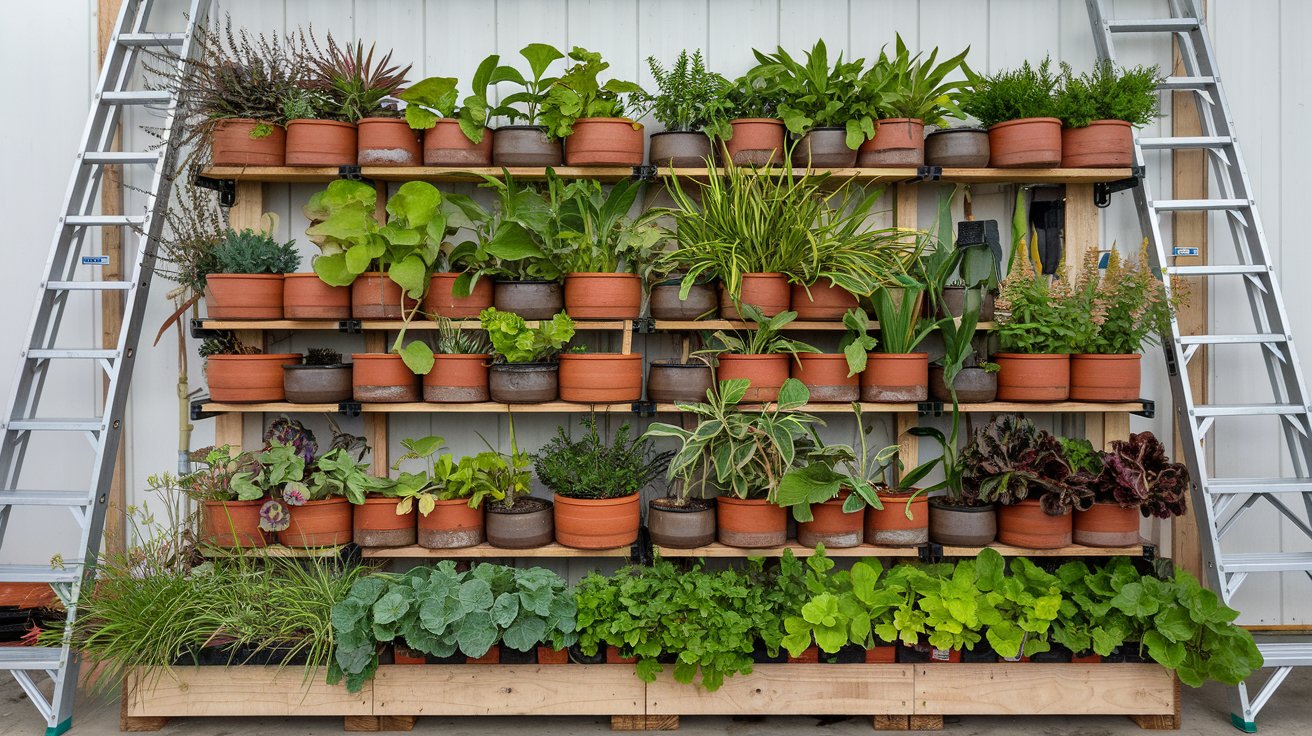Are you ready to dive into the colorful world of gardening? If you’re a beginner looking to cultivate your own vibrant blooms, you’re in the right place! Growing flowers not only brightens your outdoor space but can also provide a wonderful sense of accomplishment. In this guide, we’ll explore some of the easiest flowers to grow, including cheerful sunflowers that tower over the garden, delicate asters that bring a splash of color in the fall, and the playful touch-me-not, known for its unique charm. Whether you have a sprawling backyard or a modest balcony, these flowers are perfect for novice gardeners eager to nurture their green thumbs. Let’s uncover the joys of planting and caring for these delightful blooms that will surely enhance your gardening journey!
Reading Time: 20 Minutes
Table of Contents
Why Choose Easy Flowers for Your Garden
When it comes to creating a vibrant and inviting garden, choosing the right plants is crucial, especially for beginners or those looking for low-maintenance options. Easy flowers like Coneflowers, cosmos, and Alyssum not only add beauty and color to your outdoor space but also offer a variety of benefits that make them ideal choices for any garden. These flowers are known for their resilience and adaptability, requiring minimal care while providing maximum visual impact.
Coneflowers, or Echinacea, are hardy perennials that thrive in a range of conditions, from full sun to partial shade. They are drought-tolerant once established, making them perfect for gardeners who prefer a low-maintenance approach. Their striking purple, pink, or white blooms attract pollinators such as bees and butterflies, enriching your garden’s ecosystem. Additionally, coneflowers are known for their medicinal properties, making them not only visually appealing but also beneficial for health-conscious gardeners.
Incorporating cosmos into your garden design adds a whimsical touch with their delicate, fern-like foliage and bright, daisy-like flowers that come in a variety of colors, including pink, white, and orange. Cosmos are annuals, which means they bloom vigorously throughout the growing season, providing continuous color. They are easy to grow from seeds, often requiring just a sunny spot and well-draining soil. Furthermore, these cheerful flowers are known for attracting butterflies, creating a lively and dynamic garden atmosphere.
Alyssum is another fantastic option for those seeking low-maintenance beauty. This charming flower thrives in cool conditions and produces tiny clusters of sweet-smelling blooms that can range from white to shades of purple and pink. Alyssum is a great choice for filling in garden beds or acting as a border because of its ability to spread and create a lush carpet of color. Additionally, it is known to attract beneficial insects, which can help improve the overall health of your garden. By choosing easy flowers like coneflowers, cosmos, and alyssum, you can create a stunning and resilient garden without the extensive upkeep often required by more demanding plants.
Essential Supplies for Growing Easy Flowers
Growing easy flowers can be a rewarding and fulfilling endeavor, especially for those who are just starting out in gardening. To set yourself up for success, it’s essential to gather a few supplies that will aid in the cultivation of beautiful blooms, such as California poppy, daylilies, and stonecrop. These flowers are not only stunning but also relatively low-maintenance, making them ideal for novice gardeners.
When starting your flower garden, the first step is to choose quality seeds or plants. California poppies are known for their vibrant orange hue and ability to thrive in various climates, making them a popular choice for beginners. Daylilies, with their wide range of colors and hardy nature, can flourish in most soils, requiring minimal upkeep. On the other hand, stonecrop, a hardy succulent, can add texture to your garden and is particularly drought-tolerant, making it perfect for those in arid regions.
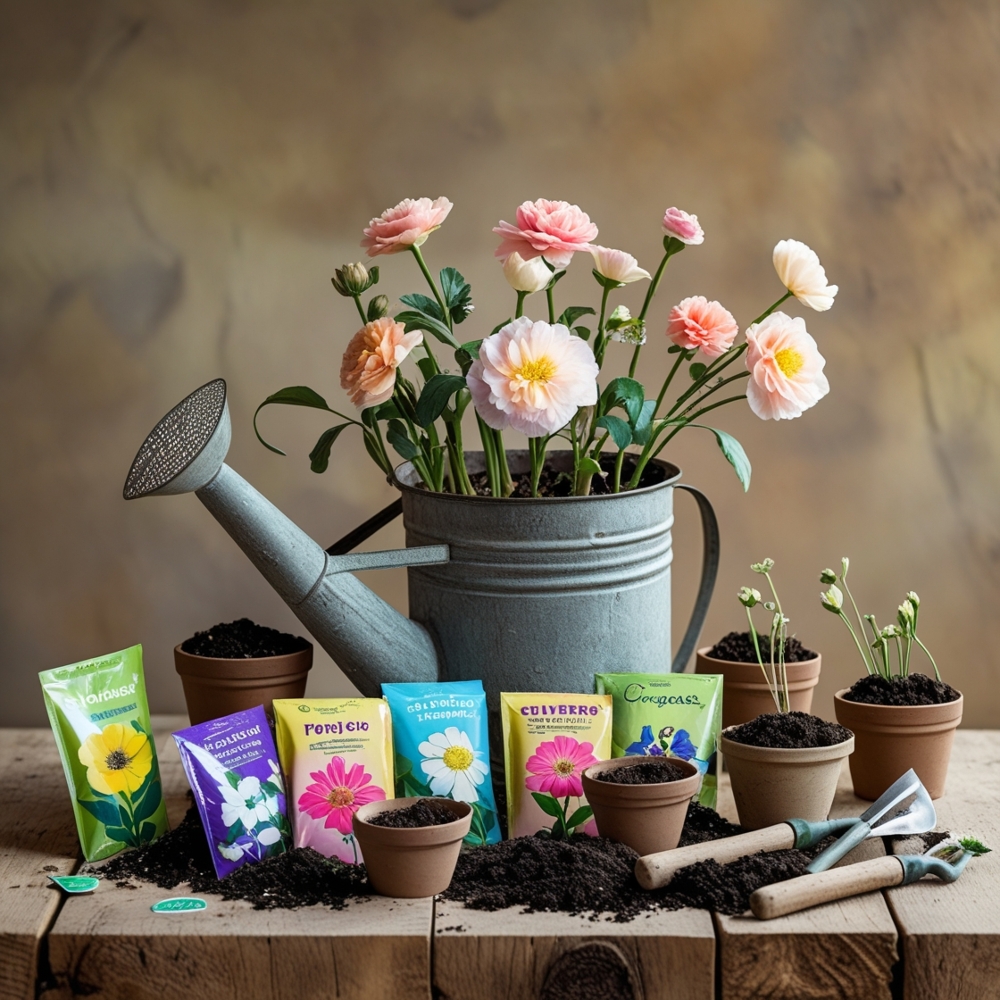
To ensure your flowers grow healthy and strong, you’ll also need to prepare the right soil mix. A balanced mixture with good drainage is crucial, as both California poppies and stonecrop prefer drier conditions and can suffer in overly wet soils. Investing in quality compost will enrich the soil, providing essential nutrients that allow your flowers to thrive. Additionally, tools like a hand trowel, garden fork, and watering can will come in handy as you plant and care for your blossoming garden.
Lastly, consider incorporating mulch as part of your gardening supplies. Mulch helps retain moisture in the soil, regulates temperature, and suppresses weeds, which can compete for nutrients. By effectively managing your garden’s environment, you’ll encourage vibrant blooms from your California poppies and daylilies while your stonecrop acts as an attractive ground cover. With the right supplies and a little patience, you can create a flourishing flower garden that brings joy and beauty to your outdoor space.
Top Easy Flowers for Beginners to Plant
For those new to gardening, choosing the right flowers can set the stage for a rewarding experience. Some varieties not only thrive with minimal care but also bring vibrant colors to your outdoor space. Among the top choices for beginners are the cheerful coneflower, the eye-catching nasturtium, and the reliable marigold. Each of these flowers is known for its resilience, making them perfect companions for novice gardeners eager to cultivate their green thumb.
The coneflower, or Echinacea, is a hardy perennial that showcases a stunning array of colors, from purples and pinks to whites and yellows. They are drought-resistant and thrive in well-drained soil, requiring only the occasional watering. Their prominent central cones not only add aesthetic appeal but also attract pollinators like bees and butterflies, enriching your garden’s biodiversity. Planting coneflowers in full sun will yield the best blooms, while their low maintenance makes them a must-have for any beginner’s garden.
Nasturtiums are another fantastic option for those starting out in gardening. These vibrant flowers feature a unique combination of orange, yellow, and red hues, bringing a burst of color to any space. Nasturtiums are not only easy to grow from seeds but also adapt well to various soil types. They thrive in poor soil without the need for fertilizers, allowing novice gardeners to simply sow the seeds, water occasionally, and watch them flourish. Additionally, their edible flowers and leaves can add a peppery flavor to salads, making them a delightful addition to your culinary endeavors.
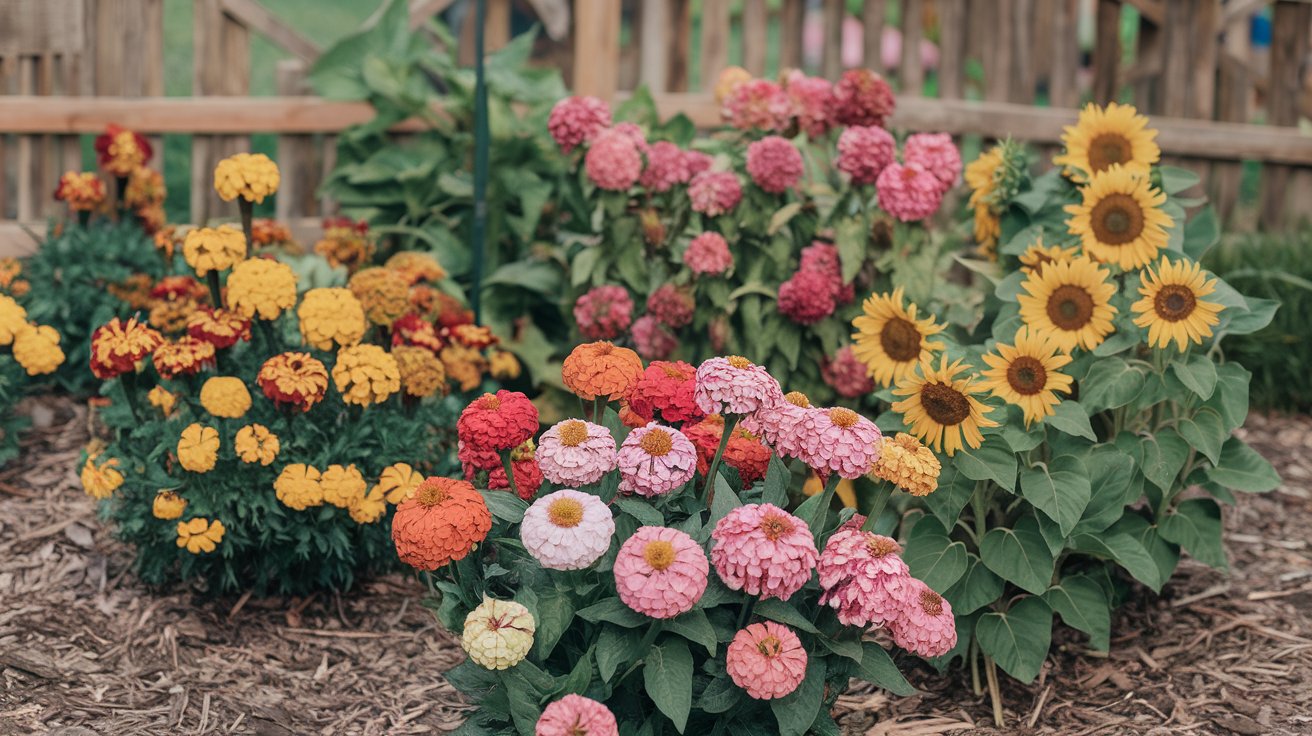
Lastly, marigolds are a classic choice for beginners looking to add splashes of color and vibrancy to their gardens. With their bright yellow and orange blooms, marigolds can thrive in various conditions and are perfect for borders, containers, or even as companion plants. They are known for their pest-repelling properties, making them valuable allies in maintaining a healthy garden. The simple act of planting marigolds can help deter harmful insects while providing a burst of sunshine to your landscape. With their easy care and multitude of benefits, marigolds are essential for any beginner gardener’s repertoire.
Step-by-Step Guide to Planting Easy Flowers
Planting flowers is a rewarding and delightful endeavor that can enhance the beauty of any garden or outdoor space. If you’re new to gardening or simply looking for easy-to-grow options, sweet peas, asters, and geraniums are excellent choices. These flowers not only add vibrant colors and textures to your garden but are also relatively low-maintenance, making them perfect for both beginners and seasoned gardeners alike.
To start your planting journey, choose a location that receives plenty of sunlight, ideally six to eight hours a day. Prepare the soil by clearing any weeds or debris, and then loosen it with a spade or fork. For sweet peas, soak the seeds overnight before planting them about an inch deep and six to eight inches apart. They love rich, well-draining soil, so consider adding compost to provide essential nutrients. Sweet peas can be trained to climb trellises or supports, allowing their beautiful blossoms to cascade gracefully as they grow.
Next, consider asters, which are often sown directly in the garden bed or started indoors a few weeks before the last frost. Plant the seeds about a quarter-inch deep and space them a foot apart to allow for their mature size. Asters thrive in a variety of soil types, but they do particularly well in moderately fertile, well-draining soil. Once established, these flowers can bring a cheerful touch to your garden, attracting butterflies and other pollinators.
Lastly, geraniums are fantastic for adding a splash of color to both garden borders and container gardens. When planting, ensure the pots or garden beds have good drainage, as geraniums do not like sitting in water. Plant them at the same soil depth as their original pots, spacing them about 12 to 18 inches apart to allow for proper air circulation. Water them thoroughly after planting and continue to provide moisture as needed, but be cautious not to over water. With some care and attention, your garden will soon be a vibrant sight, showcasing the charm of sweet peas, asters, and geraniums in full bloom.
Tricks for Maintaining Healthy Easy Flowers
When it comes to maintaining a vibrant and effortless flower garden, incorporating easy-to-care-for varieties such as zinnias, begonias, and catmint can make all the difference. Zinnias are incredibly resilient and thrive in full sun, making them perfect for novice gardeners. These colorful blooms not only enjoy well-drained soil but also benefit from regular deadheading, which encourages new growth and prolongs their blooming period. With their wide array of colors and sizes, zinnias can effortlessly bring life and color to any garden space.
Begonias are another fantastic choice for maintaining a flourishing floral display with minimal effort. These versatile plants can thrive in both sun and shade, allowing for flexibility in your garden layout. To keep begonias healthy, it’s important to monitor their watering needs; they prefer a consistent moisture level but should never be waterlogged. Incorporating a layer of mulch around the base can help retain moisture in the soil while suppressing weeds, giving your begonias the perfect environment to thrive.
Catmint adds a delightful touch to any flower garden, and it is incredibly easy to maintain. Known for its aromatic foliage and stunning purple blooms, catmint is drought-resistant once established, making it an excellent addition for those looking to minimize watering chores. Regular trimming after the first bloom encourages a second round of flowers and keeps the plant looking tidy. Additionally, catmint attracts pollinators such as bees and butterflies, enriching the biodiversity of your garden while providing lovely blooms throughout the season.
By choosing the right flowers and implementing a few simple care techniques, maintaining a beautiful garden does not have to be a daunting task. With zinnias, begonias, and catmint in your floral repertoire, you can enjoy a vibrant landscape that thrives with minimal effort, allowing you to sit back and appreciate the beauty of nature surrounding you.
Common Mistakes to Avoid When Growing Easy Flowers
Growing easy flowers like lavender, sweet pea, and petunia can be a rewarding experience for any gardener, but there are common mistakes that can hinder your success. One primary mistake is planting these flowers in the wrong location. For instance, lavender thrives in full sun and well-draining soil, while sweet peas prefer a cooler spot with partial shade. If these flowers are placed in unsuitable conditions, you may find that they struggle to grow, resulting in disappointing blooms.
Another error many gardeners make is over watering or under watering their plants. Lavender, for example, is drought-tolerant and prefers to dry out between watering. In contrast, sweet peas need consistent moisture to fuel their climbing growth and produce flowers. Petunias, while more forgiving, can suffer from root rot if planted in soil that does not drain well. Understanding the specific water needs of each flower is crucial for maintaining vibrant and healthy plants.
Fertilization is another aspect that requires careful attention. Some gardeners assume that more fertilizer means more blooms, but this is not always the case. Over-fertilizing can lead to lush foliage at the expense of flower production, especially in flowers like petunias that may become leggy without proper care. A balanced approach to feeding your plants at the right stages of growth can significantly enhance their flowering potential.
Lastly, neglecting pest and disease management can also prove detrimental. While lavender is generally pest-resistant, sweet peas can fall victim to aphids and diseases like powdery mildew. Regular monitoring and adopting preventive measures can keep your garden healthy. By avoiding these common mistakes, you can ensure that your easy flowers flourish, bringing beauty and color to your outdoor spaces.
Creative Ways to Display Your Easy Flowers
When it comes to adding a touch of charm and color to your living space, displaying flowers like cranesbill, pansy, and peonies can be a delightful endeavor. These easy-to-grow blooms not only brighten up your garden but can also become stunning focal points throughout your home. One creative way to showcase them is through wall-mounted planters. Choose vibrant pots or repurpose wooden crates to create a vertical garden. This not only saves space but also offers an eye-catching display, especially when integrating the soft purples of pansies and the bold hues of peonies.
Another unique approach is utilizing glass containers for an airy, modern look. Cut the stems of your cranesbill just right, and place them in clear vases filled with water, allowing their delicate leaves to float elegantly. Pair these with small floral arrangements of pansies and peonies in bud vases scattered across your dining table or shelves. The transparency of the glass highlights the rich colors and intricate details of each flower, making them a centerpiece that draws the eye while adding elegance to the room.
If you want a more rustic feel, consider using mason jars as your vessels. These can be filled with a mix of peonies and cranesbill, complemented by wildflowers for an effortless wildflower arrangement. The juxtaposition of the smooth glass with the soft petals creates an inviting atmosphere, perfect for casual gatherings or a cozy breakfast nook. Finally, don’t forget to incorporate natural elements into your displays. A simple wooden stump or slice, topped with a small arrangement of pansies, can make a beautiful and organic decorative piece that connects your floral displays to nature.
Ultimately, there are countless ways to creatively showcase your easy flowers. The key is to experiment with different materials and arrangements until you find a display that reflects your style. Whether you opt for a more structured look with wall-mounted planters or a casual vibe with mason jars, each display can serve as a beautiful reminder of the simple joys that blooms like cranesbill, pansy, and peonies can bring into our lives.
Seasonal Care Tips for Easy Flowers
As the seasons change, so too should our approach to caring for seasonal flowers like calendula, aster, and ipomoea. These vibrant blooms add a splash of color to our gardens and homes, but they also require specific attention to thrive throughout the year. By understanding their unique needs, we can ensure that they not only survive but flourish in their respective seasons.
Calendula, often referred to as pot marigold, is known for its resilience and cheerful orange and yellow flowers. This hardy annual prefers cooler temperatures, making it ideal for early spring and fall gardens. To care for calendula, ensure they are planted in well-drained soil and receive plenty of sunlight. Regular deadheading encourages continuous blooming, while occasional watering keeps the soil moist but not soggy. This will help maintain the plant’s health and vibrancy throughout the cooler months.
Aster, on the other hand, brings a burst of color in late summer and fall. These perennial favorites thrive in full sun and well-drained soil, but they can struggle in overly rich conditions. It’s best to avoid excessive fertilization, or it may lead to leggy growth. During the autumn months, asters attract pollinators, so avoiding pesticides is vital to preserving their beneficial insects. Additionally, cutting back spent flowers can promote a more bushy growth in the following year.
Ipomoea, commonly known as morning glory, is a climber that benefits from warm weather and full sun exposure. This flowering vine can be a great addition to trellises and fences, providing beautiful blooms throughout summer. Regular pruning can help manage its growth, enabling more vibrant flowers and a healthier plant overall. As summer transitions to fall, it’s essential to monitor for pests, which are drawn to the lush foliage. With the right seasonal care, ipomoea can beautify your outdoor space and bring a lively energy to your garden. By understanding the specific needs of each of these stunning flowers, you can enjoy their beauty throughout the seasons.
How to Extend the Blooming Season of Easy Flowers
If you’re looking to extend the blooming season of easy flowers to grow in your garden, several strategies can help you achieve a vibrant display of color throughout multiple seasons. One of the most effective methods is to choose a diverse array of flowers that bloom at different times. Selecting early bloomers such as crocuses or daffodils, alongside mid-season favorites like coneflowers and daylilies, and late bloomers such as asters or chrysanthemums, ensures that something is always in bloom. By strategically planning your planting schedule, you can create a continuous flow of colors that enhances the beauty of your garden.
Another crucial tip to prolong your blooming period is to practice succession planting. This technique involves staggering the sowing of seeds or the planting of bulbs over time. For instance, if you’re growing easy flowers to grow from seed, you can sow the seeds of annuals like zinnias or cosmos in intervals every few weeks. This approach not only ensures a succession of blooming flowers but also maximizes the use of your garden space. By maintaining healthy soil and providing adequate care, your garden can offer a feast of blooming flowers that lasts from spring until the first frost.
Deadheading is another essential practice that can significantly extend the blooming season of your favorite flowers. By removing spent blooms, you encourage your plants to focus their energy on producing new flowers instead of setting seeds. Many easy flowers to grow, such as petunias or geraniums, respond exceptionally well to deadheading and will reward your effort with persistent blooms. Additionally, ensuring that your flowers get the right amount of sunlight, water, and nutrients can help maintain their vigor and promote more extended blooming periods.
Lastly, consider incorporating perennial flowers into your garden plan. While annuals may provide a burst of color in the short term, perennials such as black-eyed Susans or peonies can return year after year, contributing to a stable and enduring floral display. By combining annuals and perennials, along with employing succession planting and proper maintenance techniques, you can create a harmonious garden brimming with a variety of easy flowers to grow, ensuring a colorful oasis that delights the senses throughout the growing season.
About Growing Easy Flowers
Growing flowers can be a rewarding experience, especially for those who are new to gardening or have limited time to dedicate to their plants. There are numerous varieties that are considered easy flowers to grow, making it easy for beginners to achieve beautiful blooms without extensive gardening knowledge. Some popular choices include marigolds, zinnias, and pansies. These flowers not only add vibrant colors to your garden but are also known for their resilience and low-maintenance requirements.
One common question among novice gardeners is when to plant these easy flowers to grow. Timing can be crucial, as many flowers thrive in specific conditions. For instance, it’s typically best to sow seeds in the spring after the last frost or in the fall for those that can handle cooler temperatures. Additionally, understanding your local climate can help you select the best varieties suited for your region, ensuring that you get the most out of your flowering plants.
Another frequent inquiry involves caring for these easy-to-grow flowers. While they are known for being low-maintenance, they still require some routine care, such as watering, deadheading spent blooms, and occasional fertilization. It’s essential to find the right balance; overwatering can lead to root rot, while too little can inhibit growth. A good rule of thumb is to keep the soil consistently moist but not soggy, as this promotes healthy development and robust flowering.
Lastly, many gardeners wonder about pest management for their flowers. Easy flowers to grow can still attract some unwanted visitors, such as aphids or slugs. The best approach often includes natural methods, such as encouraging beneficial insects like ladybugs or using organic repellents. By keeping a close eye on your garden and addressing any issues early, you can maintain a vibrant and thriving flower bed that brings joy and beauty to your outdoor space.
Frequently Asked Questions
What are the easiest flowers to grow for beginners?
There are many easy-to-grow flowers perfect for beginners. Sunflowers are a great choice because they’re hardy and grow fast. They need full sun and regular water to bloom.
Marigolds are also easy to grow and add vibrant colors to your garden. They also help keep pests away. Zinnias are another beginner-friendly option. They love the sun, need little care, and bloom all summer.
Lavender is easy to grow and smells great, needing well-drained soil and sun. Cosmos flowers are low-maintenance and drought-tolerant. They bloom beautifully with little effort.
Pansies are perfect for cooler climates and add color to your garden in early spring or fall. These flowers are easy to care for but bring lots of beauty all season.
How do I care for easy flowers to grow in my garden?
Caring for easy-to-grow flowers is simple and can be very rewarding! First, make sure to plant them in a spot that gets plenty of sunlight, as most flowers, like sunflowers, marigolds, and zinnias, thrive in full sun. Check the specific needs of each flower variety, but generally, aim for at least 6 hours of sunlight a day.
Watering is essential, but be careful not to overdo it. Most flowers prefer the soil to dry out slightly between waterings, especially if they are drought-tolerant like lavender or cosmos. Deep watering is better than frequent shallow watering, as it encourages strong root growth.
Adding a layer of mulch around your flowers helps retain moisture, control weeds, and regulate soil temperature. Regularly remove spent blooms to encourage new growth, a process called deadheading, and keep an eye out for pests. Finally, feed your plants with a balanced fertilizer during their growing season to give them a boost and keep them blooming beautifully!
When is the best time to plant easy flowers to grow?
The best time to plant easy-to-grow flowers largely depends on the type of flower and the climate in your area. For most flowers, spring is the ideal time, once the risk of frost has passed and the soil has warmed up. This is typically around mid to late April or early May, depending on your location.
For flowers like sunflowers, zinnias, and marigolds, planting after the last frost ensures they have the warm temperatures they need to grow. If you live in a region with mild winters, you can plant early spring or even fall, especially for hardy flowers like pansies or calendulas.
In warmer climates, it might be possible to plant certain flowers year-round. However, it’s still essential to watch for the right planting windows—such as waiting until temperatures are consistently warm—since many flowers, like lavender or cosmos, thrive best in warmer soil. For the best results, always check local planting guides tailored to your specific area.
Do easy flowers to grow require a lot of sunlight?
Most easy-to-grow flowers do require a good amount of sunlight to thrive, but the exact amount can vary depending on the type of flower. Flowers like sunflowers, marigolds, and zinnias are known for needing full sunlight—typically around 6 to 8 hours a day—to grow strong and produce vibrant blooms. These flowers love the sun and do best in bright, sunny spots in the garden.
However, there are some easy flowers that can tolerate partial shade. For instance, pansies and begonias can do well in areas that get a bit of shade, especially in hotter climates where too much direct sun can cause them to wilt. Similarly, lavender prefers plenty of sunlight but can handle some afternoon shade, especially in areas with very hot summers.
So, while many of the easiest flowers to grow thrive in full sun, it’s important to match the flowers with the conditions of your garden to get the best results.
What are the most low-maintenance easy flowers to grow?
When looking for low-maintenance, easy-to-grow flowers, there are several great options that require minimal effort while still adding beauty to your garden. Marigolds are a top choice—they’re hardy, resistant to pests, and thrive with just a little sun and water. Once planted, they don’t need much attention to keep blooming all season long.
Zinnias are another fantastic option, known for being both drought-tolerant and resilient to various weather conditions. They love full sun and, once established, can grow with little upkeep. Similarly, sunflowers are relatively low-maintenance, needing only sunlight, occasional watering, and enough space to grow tall.
For a fragrant, low-maintenance choice, lavender is ideal. It’s drought-resistant, thrives in well-drained soil, and can go without frequent watering once established. Additionally, black-eyed Susans are hardy perennials that come back year after year, requiring little care aside from occasional deadheading to encourage new blooms. These flowers not only look beautiful but also attract pollinators, making them an excellent choice for easy gardening.
Can I grow easy flowers to grow in containers or just in the ground?
Yes, many easy-to-grow flowers can thrive both in containers and in the ground, making them versatile for different gardening setups. Flowers like marigolds, petunias, and zinnias do particularly well in containers because they don’t require a lot of space and can adapt to smaller environments. Containers also make it easier to control the soil and moisture levels, which is great for plants that prefer well-drained conditions.
Sunflowers, though typically grown in the ground, can also be grown in large containers as long as they have enough space for their roots to spread out. Lavender, another easy flower, grows beautifully in pots, especially if you want to move it to a sunnier spot during the day or bring it indoors during colder months.
Growing flowers in containers also offers the benefit of mobility, allowing you to position them where they’ll get the most sunlight or even move them to avoid bad weather. Just be sure to choose a large enough container and ensure proper drainage for healthy growth.
Author Bio:

Robert Martin is a passionate blogger and versatile content creator exploring the intersections of personal finance, technology, lifestyle, and culture. With a strong background in financial literacy and entrepreneurship, he helps readers make smarter money moves, build sustainable side hustles, and achieve financial independence.
Beyond finance, Robert shares his insights on home decor and gardening—offering practical ideas for creating beautiful, functional living spaces that inspire comfort and creativity. He also dives into the dynamic worlds of sports and celebrity news, blending entertainment with thoughtful commentary on trends that shape today’s pop culture.
From decoding the latest fintech innovations to spotlighting everyday success stories, Robert delivers content that’s informative, relatable, and actionable. His mission is to empower readers to live well-rounded, financially confident lives while staying inspired, informed, and ahead of the curve.

